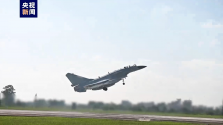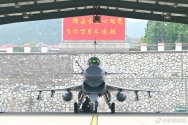I suppose even though this year's Falcon Strike exercises will focus on ground attack they will still have an air-to-air component to it? Seeing as it's carrying an AAM in the picture.Strangely I still had the J-10 thread open … but here you go, a J-10C in Thailand
View attachment 95760
You are using an out of date browser. It may not display this or other websites correctly.
You should upgrade or use an alternative browser.
You should upgrade or use an alternative browser.
J-10 Thread IV
- Thread starter Jeff Head
- Start date
I suppose even though this year's Falcon Strike exercises will focus on ground attack they will still have an air-to-air component to it? Seeing as it's carrying an AAM in the picture.
During penetration strike missions two J-10C will provide escort so they need AA munition. They are testing how PLAAF strike package works against NATO style air defense.
plawolf
Lieutenant General
Spicy, although I suspect this is less a case of testing, and more about demonstrating how PLAAF strike packages can penetration NATO style air defences for when the Thai military inevitably spill the beans on all the details of the exercises to their friends in the US and NATO military.During penetration strike missions two J-10C will provide escort so they need AA munition. They are testing how PLAAF strike package works against NATO style air defense.
During penetration strike missions two J-10C will provide escort so they need AA munition. They are testing how PLAAF strike package works against NATO style air defense.
Uh, source?
Do we have any indication that the "representative opfor" in this case will be a "NATO style air defense"?
Or is the idea that the representative opfor would be the RTAF's air defenses, in which case, are we implying that the RTAF's air defenses are "NATO style"? Because if that's the case, I think that's a bit of a sweeping generalization. Yes, RTAF have Erieye and Gripens, but some 4th gen fighters and an AEW&C from a NATO country does not a "NATO style air defense" make.
Let's recall, that the air to ground and air to air and enabling elements that the PLAAF have sent to this exercise is rather low.
A small number of JH-7As and some J-10C/S as escort, and a KJ-500 are fine as a small force for conducting very limited strike missions with aerial escort and with a AEW&C for coordination and airspace early warning and control.
But to penetrate a proper "NATO style air defense" you'd need dozens of air superiority fighters and strike aircraft, multiple escort jammers, multiple standoff jammers, and multiple ELINT/SIGINT and AEW&C aircraft as well.
You'd need 100+ aircraft for a Red Sword scale exercise at minimum, to counter a competent realistic threat.
Personally, I suspect that with the package that they've sent for this exercise with the RTAF -- and given the complexity and sophistication of the RTAF themselves -- their air to ground/strike exercises will likely just be doing procedures for conducting a relatively low scale strike mission (including mission planning, ability to acquire a target and possibly changing targets in real time during the flight), in a relatively permissive simulated environment where the J-10C/S could be providing air superiority escort.
Perhaps they might throw in a couple of opfor fighters acting as defensive interceptors, in which case the J-10C/S will have an air to air component in the exercise
But the overall exercise itself should be a relatively simple, tactical scale exercise at best with minimal requirement to actually conduct air to ground EW, SEAD or DEAD, and certainly not required to counter a "NATO style air defense".
That isn't to say the exercise won't be useful -- people somewhat underestimate the complexities of being able to do competent and efficient air to ground strike missions and the procedures and systems needed to do so.
If the PLA are able to see how the RTAF do air to ground strike missions (given that sort of tactical training would certainly be derived from NATO procedures), that could help them further modify and smooth out their own TTPs.
The whole mission from:
-planning on the ground
-sortie with (hopefully) a targeting pod and some PGMs
-navigation
-location and identification of targets
-designation of targets, strike
-post strike BDA
... all of those generic things can be learned and refined.
Additional complex factors like inflight retargeting, targeting of simulated moving targets or time sensitive targets, are also useful to see how the RTAF go about it. And the above of course would all be in context of having coordination with your friendly fighter escort doing their air to air mission, and your AEW&C doing their job as well.
If there are elements of ground to air coordination in the form of TACPs/JTACs, then it would be infinitely even more useful for the PLA, but perhaps that is wishful thinking a bit, as that I imagine would be closely guarded by the RTAF.
Last edited:
Probably not many made fun of him if he was already muscular in school.handsome guy, very muscular, but his name is pretty girly, not sure if anyone make fun of his name back in school

J-10C from Eastern Theater Command (those with domestic engine) participated in an aerial combat exercise in the Taiwan Strait. This one is carrying live AAM (probably PL-10 and PL-15 or PL-12 combo).
How can I tell that a medium range missile is carried? Easy. PL-10 has a relatively round tip. The sharp nose behind it could only be a PL-15 or PL-12.











